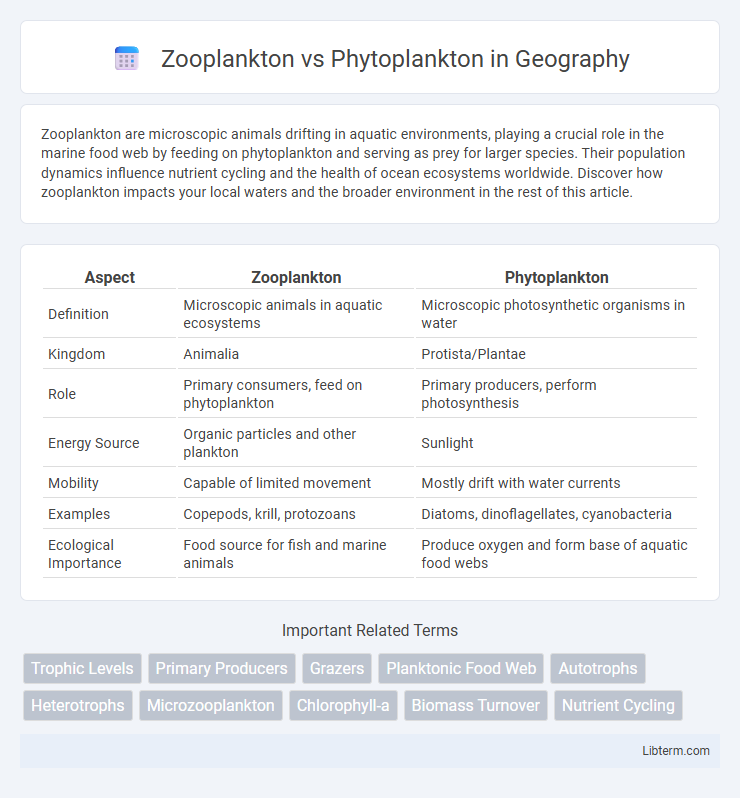Zooplankton are microscopic animals drifting in aquatic environments, playing a crucial role in the marine food web by feeding on phytoplankton and serving as prey for larger species. Their population dynamics influence nutrient cycling and the health of ocean ecosystems worldwide. Discover how zooplankton impacts your local waters and the broader environment in the rest of this article.
Table of Comparison
| Aspect | Zooplankton | Phytoplankton |
|---|---|---|
| Definition | Microscopic animals in aquatic ecosystems | Microscopic photosynthetic organisms in water |
| Kingdom | Animalia | Protista/Plantae |
| Role | Primary consumers, feed on phytoplankton | Primary producers, perform photosynthesis |
| Energy Source | Organic particles and other plankton | Sunlight |
| Mobility | Capable of limited movement | Mostly drift with water currents |
| Examples | Copepods, krill, protozoans | Diatoms, dinoflagellates, cyanobacteria |
| Ecological Importance | Food source for fish and marine animals | Produce oxygen and form base of aquatic food webs |
Introduction to Plankton: Zooplankton vs Phytoplankton
Zooplankton are microscopic animals that drift in aquatic environments, serving as primary consumers by feeding on phytoplankton and other small organisms. Phytoplankton are photosynthetic microorganisms that form the base of aquatic food webs, producing oxygen and organic compounds through photosynthesis. Together, zooplankton and phytoplankton regulate nutrient cycling and energy flow in marine and freshwater ecosystems.
Defining Zooplankton: Characteristics and Types
Zooplankton are heterotrophic microscopic organisms that drift in aquatic environments, feeding on phytoplankton or other small particles. Their characteristics include diverse morphologies, ranging from copepods and krill to protozoans and jellyfish larvae, making them vital components of marine and freshwater food webs. Zooplankton serve as primary consumers, linking photosynthetic phytoplankton to higher trophic levels through their grazing activities and nutritional roles.
Defining Phytoplankton: Characteristics and Types
Phytoplankton are microscopic, photosynthetic organisms that form the foundation of aquatic food webs by converting sunlight into energy through chlorophyll pigments. Key characteristics include their ability to produce oxygen, rapid reproduction rates, and diverse forms such as diatoms, dinoflagellates, and cyanobacteria. These autotrophic plankton vary in size and shape, adapting to different water conditions and significantly influencing global carbon cycles.
Structural Differences Between Zooplankton and Phytoplankton
Zooplankton are primarily heterotrophic organisms with complex cellular structures and often possess specialized appendages for locomotion, whereas phytoplankton are autotrophic, unicellular or colonial algae with simple cell structures containing chloroplasts for photosynthesis. Phytoplankton have rigid cell walls composed of cellulose or silica, providing structural support, while zooplankton typically lack such rigid exteriors, exhibiting more flexible and varied morphologies. The size range of zooplankton usually surpasses that of phytoplankton, reflecting their differing ecological roles as consumers versus primary producers in aquatic ecosystems.
Role in Aquatic Food Webs
Zooplankton serve as primary consumers in aquatic food webs by feeding on phytoplankton, which are photosynthetic producers converting sunlight into organic matter. Phytoplankton form the base of the aquatic food chain, generating oxygen and organic nutrients that support a variety of marine organisms. This dynamic between zooplankton and phytoplankton is crucial for energy transfer and maintaining ecosystem balance in oceans and freshwater habitats.
Reproduction and Life Cycles
Zooplankton primarily reproduce through sexual means, with many species exhibiting complex life cycles that include larval stages and metamorphosis. Phytoplankton typically reproduce asexually by binary fission, enabling rapid population growth under favorable conditions, though some species also engage in sexual reproduction to enhance genetic diversity. These differences in reproduction and life cycles influence their ecological roles, with zooplankton contributing to nutrient cycling through predator-prey dynamics and phytoplankton forming the base of aquatic food webs via photosynthesis and biomass production.
Feeding Habits: Autotrophs vs Heterotrophs
Zooplankton are heterotrophic organisms that feed on phytoplankton, bacteria, and other small particles, relying on consuming organic material for energy. Phytoplankton are autotrophic, using photosynthesis to convert sunlight into energy, forming the base of aquatic food webs. This fundamental difference in feeding habits distinguishes zooplankton as consumers and phytoplankton as primary producers.
Ecological Importance and Functions
Zooplankton play a crucial role in aquatic food webs by serving as primary consumers that feed on phytoplankton and transfer energy to higher trophic levels such as fish and marine mammals. Phytoplankton contribute significantly to global oxygen production through photosynthesis and act as primary producers supporting oceanic carbon cycling and nutrient dynamics. Together, zooplankton and phytoplankton regulate ecosystem productivity and maintain the balance of marine and freshwater habitats.
Environmental Factors Affecting Plankton Populations
Environmental factors such as temperature, light availability, and nutrient concentrations critically influence zooplankton and phytoplankton populations, with phytoplankton growth relying heavily on sunlight and dissolved nutrients like nitrogen and phosphorus. Zooplankton populations are affected by water temperature and the abundance of phytoplankton as their primary food source. Variations in salinity and pH further modulate plankton distribution, impacting aquatic ecosystem dynamics and productivity.
Zooplankton and Phytoplankton in Climate Regulation
Zooplankton and phytoplankton play crucial roles in climate regulation by influencing carbon cycling in aquatic ecosystems. Phytoplankton perform photosynthesis, absorbing significant amounts of CO2 and producing oxygen, which helps mitigate greenhouse gas levels. Zooplankton consume phytoplankton, facilitating the transfer of carbon to deeper ocean layers through biological carbon pumps, enhancing long-term carbon sequestration.
Zooplankton Infographic

 libterm.com
libterm.com